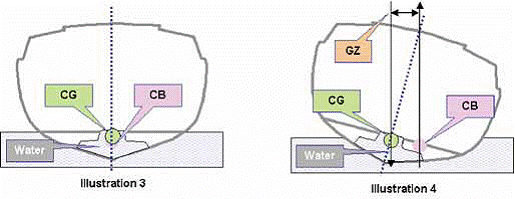|
Technically
Speaking—How Water Ballast Works
By; Ramblin’ Rod
Brandon
rodney.brandon@sympatico.ca
First
Published in Clipper Snips the magazine of the Trailer/Sailors
Association Fall 2007 Pg 10
I
remember as a young
child, my father posing the question, “What weighs more, a pound of feathers
or a pound of lead?” Of course the answer is, that they both weigh exactly the
same. This is a critical premise to understanding how water ballast works.
Some
people believe that because water has neutral buoyancy in water, that water
ballast would have to be lifted above the waterline, to have any effect on
righting moment. This isn’t true. To understand why, one needs to know how
righting moment is generated.
 Every vessel has a centre of gravity (CG) and a centre of buoyancy (CB). The
centre of gravity is the axis on which the boat will tend to roll when heeled.
The centre of buoyancy is the relative volumetric centre of the water displaced
by the vessel.
Every vessel has a centre of gravity (CG) and a centre of buoyancy (CB). The
centre of gravity is the axis on which the boat will tend to roll when heeled.
The centre of buoyancy is the relative volumetric centre of the water displaced
by the vessel.
As
the boat heels, CG remains stationary, whereas CB shifts laterally. The lateral
distance between CG and CB is proportional to the righting moment GZ. The
greater this distance, the stiffer the boat will be.
Dense
ballast such as lead has the benefit of lowering CG which helps extend GZ. Since
water ballast must be carried higher in the vessel, raising the CG, more weight
in water ballast is required to create the same GZ as lead.
 Note
how in Illustration 4, the water in the ballast tank is not raised above the
waterline outside of the vessel, and yet contributes significantly to righting
moment. Without the water ballast, the CG would
be much higher still, resulting in less GZ. This is why a water ballasted boat
is so much more “tipsy” (technical term totally unrelated to beer or rum
ballast), before the water ballast is loaded. Note
how in Illustration 4, the water in the ballast tank is not raised above the
waterline outside of the vessel, and yet contributes significantly to righting
moment. Without the water ballast, the CG would
be much higher still, resulting in less GZ. This is why a water ballasted boat
is so much more “tipsy” (technical term totally unrelated to beer or rum
ballast), before the water ballast is loaded.
Water
ballast must be raised above the water line to be effective? Myth busted!
|